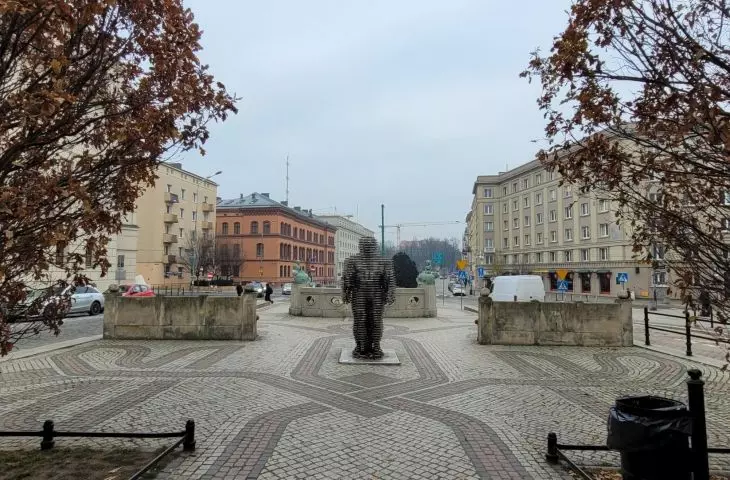Almost thirty years of waiting and—finally a change! The oldest city avenues in Poland will finally cease to be a cross between a threshing floor and a parking lot. After many decades, the devastated section will again be planted with oak trees. Today cars park in their place.
There is a chance that one of the biggest scandals in the space of Poznan's downtown will end. The city of Poznań has finally decided to fully restore the splendor of one of the city's more significant streets—Marcinkowski Avenue. One third of this tract, devoid of trees and serving as a parking lot, today looks worse than many a street in the suburbs. Meanwhile, the Avenues were originally laid out, as a representative promenade, in the early 19th century by the Prussian authorities. At the time, the expansion of the city, which was freed from medieval walls, was underway. The new part of Poznań was planned from the west, on a hill known as Musa Gora.
Like Unter den Linden
The avenue was named Wilhelm Street. Delineated on a north-south axis, they formed a kind of border between the new and old city, leading toward St. Adalbert's Hill. Located higher up, they offered interesting views and fresh air, and were adjacent to the newly established representative Wilhelm Square (now Liberty Square) with the city's first theater. At first they were planted with rows of Italian poplars. The whole area was inspired by the shape of Berlin's Unter den Linden avenue. Historians note that it is the oldest urban promenade of this type in today's Polish lands. Together with the square, the avenue was the most representative part of the expanded city in the 19th century.
Marcinkowskiego Avenues in the 1830s (Wilhelmowska Street), on the left Freedom Square (Wilhelm Square), opposite—Raczynski Library—Raczynski Library.
Photo: engravings by J. Minutoli from the collection of the Provincial Office for Monuments Protection
© tract.poznan.pl
Throughout the 19th century, the tract grew with significant buildings, including: The Raczynski Library (on the corner of the square), the main headquarters of the post office, the edifices of the Credit Lands (today UAP), the court and the customs office (today Police). Just off the Avenue, the famous Bazar was built in 1838, which was both a hotel and the center of Polish economic and cultural life. Other grand hotels were also built, and the street gained a striking closure of the axis on the north side in the form of a military commandery. At the beginning of the 20th century, the building of the Emperor Frederick III Museum (today the National Museum) was built along the avenues. A rich collection of images of the Avenues from the past two centuries can be found here.
bristling and devastated
Thesplendor of the thoroughfare ended in 1945. The destruction in this part of the city was extensive. The damaged commandery was demolished, the courthouse was rebuilt in a simplified form. The gaping holes left by the residential houses haunted for many postwar decades. In the 1960s, there were plans to incorporate the avenues into an expressway that would have unceremoniously cut up the old downtown. Fortunately, this did not happen. Instead, the construction of a new wing of the National Museum with an unfortunate modernist form (completed in 2000) took nearly thirty years along the avenues. In 2013, on the other hand, the successful new wing of the Raczynski Library (designed by JEMS Architekci) and the extremely misguided Pasaż MM shopping center (designed by Studio ADS) opened at the southern end of the thoroughfare.
Marcinkowskiego Avenues, Poznań, 2022—devastated northern part,
1. view from 23 Lutego St., in the background—foreground of St. Adalbert Hill
2. view from Solna St., on the right: District Court, Police building, in the background University of Arts
Photo: Jakub Głaz
And what about the greenery? The street was planted after the war with not the most well-chosen species of trees. Most of them withered or didn't have a chance to grow, and by the late 1980s the avenue, with its severely thinned stand of trees, presented a pitiful sight. It wasn't until the next decade, in the office of the then-city visual artist, that projects for revaluation were created by Prof. Wojciech Krzyzaniak.
Marcinkowskiego Avenue, concept by Prof. Wojciech Krzyzaniak, illustration from 2012 showing the intentions from the last decade of the 20th century.
© FB / Mariusz Wisniewski
However, the concept was not implemented in its entirety. In 2000, a moderately successful modernization, inconsistent with the professor's intentions, covered a short southern section, and two years later two rows of columnar oaks were planted along the central section of the route—between Liberty Square and 23 Lutego Street (the form of the oaks was to refer to poplars from the early 19th century, although different species had also grown in the Avenues in the meantime). An ornamental floor was made there, too, according to Krzyzaniak's design. Over the past twenty years, the trees have grown heavily, creating a friendly green screen that shields the pedestrian thoroughfare in the middle.
Marcinkowskiego Avenues, Poznań, 2022—The central part revalorized in 2002/2003
Photo: Jakub Głaz
parking most important!
Instead, almost nothing has changed in the most devastated northern part (from 23 Lutego Street to Solna Street), where the District Court and the Old Town Police Station stand. Almost, because in 2005 a monument to the avenue's patron, Karol Marcinkowski, was erected there. And so, for 17 years, the figure of the distinguished doctor and social activist has been presented against the background of a combination of a threshing floor and a parking lot. Why did it take so long? Resistance came from both residents, fearing the loss of parking spaces, and from the Court and the Police along with their interests. The city, however, showed little determination to change this state of affairs.
Marcinkowski Avenue, Poznań, 2022—Marcinkowski monument in the devastated northern part of the Avenue
photo: Jakub Głaz
Only now, when the southern section of Avenues is being visually matched to the part planted with oak trees as part of the so-called "Center Project" (a thorough rebuilding of the revitalization of downtown streets), has an announcement been made about the renewal of the devastated northern part.
Aleje Marcinkowskiego, Poznań, 2022—new columnar oaks in the southern part of the avenue will form a coherent whole with the central part of the promenade
photo: Jakub Głaz
According to the deputy mayor of Poznan Mariusz Wisniewski, the design of the floor will be based on Prof. Krzyzaniak's concept from almost thirty years ago. There will be no competition, a tender has been announced. Wisniewski informed on Facebook:
We will expect the future designer to prepare a two-variant conceptual design [...] and then a construction and implementation design based on one selected variant.
Thus, there is a chance that downtown Poznań will finally regain the green space of the Avenues, which is important not only for aesthetic and historical reasons, but also—for climatic reasons. The tree-lined Avenues will weaken the effect of the urban heat island, and a retention and irrigation system is also planned.
it's not over yet
Marcinkowskiego Avenues, Poznań, visualization of completely new tree planting in front of the National Museum as part of the Centrum Project, designed by Studio ADS
© Studio ADS / Poznan Municipal Investments
New (and immediately tall) oak trees have already been growing for two weeks on the south side (Centrum Project), and will soon appear on the section between the National Museum and Liberty Square. When the northern part is enriched with them, residents will regain a friendly walking route after decades. Unfortunately, the city's plans do not provide for any urban accent at the closure of the street's axis, where the commandant's office once stood. In addition, the avenue connects here with the very busy Solna Street, an urban expressway, which, unfortunately, was realized in the 1970s.
Marcinkowskiego Avenues, Poznań, 2022
1. northern end of Avenues, intersection with Solna Street, in the background—green area under St. Adalbert's Hill, behind it—construction of a residential enclave (designed by JEMS Architekci)
2. intersection with Solna Street, view to the south (in the foreground)
Photo: Jakub Głaz
Only when the character of this thoroughfare is calmed down and its cross-section narrowed, will Marcinkowskiego Avenue have a chance to functionally and spatially merge with the green enclave and Jordan garden at the foot of St. Adalbert's Hill. The situation will soon be changed by the ongoing construction of residential houses behind the greenery (designed by JEMS Architekci), the design of which we showed here.






























































